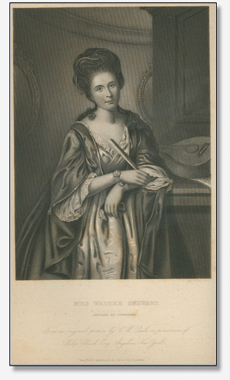
Rufus W. Griswold, The Republican Court, or, American Society in the Days of Washington. New and rev. ed. (New York, 1856),plate opposite 409 (i.e., frontispiece to Supplemental chapter). First ed., 1855.
DEBORAH MCCLENAGHAN STEWART (1763-1823) Deborah McClenaghan was born in Germantown, Pennsylvania, the oldest daughter of a successful Irish-born merchant, Blair McClenaghan, and his wife Ann Darrach.[1] In 1780, her father was instrumental in starting a fund to support George Washington’s army after the general had written to Thomas Paine saying that he was worried that short supplies would cause mutiny in his ranks.[2] The following year, on April 11, 1781, Deborah McClenaghan married Walter Stewart (1756-1796), a native of Londonderry who had joined the Continental army as a captain, risen to colonel in the Thirteenth Pennsylvania Battalion, served as aide-de-camp to General Horatio Gates, and been promoted to brigadier general. After the war, he became a merchant in Philadelphia. The Stewarts—he, “reputed to be one of the handsomest men of his day,” and she, “a beautiful woman, and a leader of society”—made their home across the street from the presidential residence occupied by their friends George and Martha Washington.[3] Together Deborah and Walter Stewart would raise eight children; perhaps as a testament to this friendship, they named their youngest child Washington.[4] Abigail Adams Smith, the daughter of John and Abigail Adams, admired Deborah Stewart, writing in her journal:
In celebration of his marriage to Deborah McClenaghan, Walter Stewart commissioned a set of paintings from Charles Willson Peale, the leading portraitist of Philadelphia: a full-length oil of him (1781), a three-quarter length oil of Deborah (1782; both at Yale University Art Gallery), and miniature portraits of each of them.[6] The miniatures were meant to be carried close to the recipients’ hearts and, no doubt, to serve as intimate personal reminders to the couple while they were apart during the war. However, as an equally intimate but far more public reminder of her devotion, Deborah chose to wear the miniature of her husband on her wrist in her formal oil portrait, and positioned him in the picture above and slightly covering a miniature of her father worn on her other wrist. This painting, a somewhat “family portrait,” was the source for the engraving of Deborah Stewart chosen by Griswold for his volume The Republican Court. Written by Annie Turner; revised by Sandra Markham. [1] Henry Simpson, The Lives of Eminent Philadelphians, Now Deceased (Philadelphia: William Brotherhead, 1859), 736. [2] “Thomas Paine.” Thomas Paine National Historic Association. http://www.thomaspaine.org/bio [3] Horace W. Smith, Life and Correspondence of the Rev. William Smith, D.D. (Philadelphia: Ferguson Bros. & Co., 1880), 2:319n [4] Rufus W. Griswold. The Republican Court, or, American Society in the Days of Washington (New York: D. Appleton and Company, 1867), 394. [5] Ibid., 297. [6] Life, Liberty, and the Pursuit of Happiness: American Art from the Yale University Art Gallery (New Haven: Yale University Art Gallery in association with Yale University Press, 2008), 207; Robin Jaffee Frank, Love and Loss: American Portrait and Mourning Miniatures (New Haven: Yale University Art Gallery in association with Yale University Press, 2000), 18-22. |

